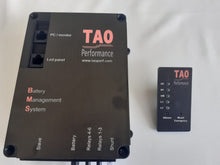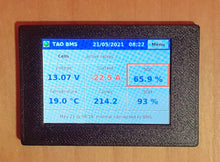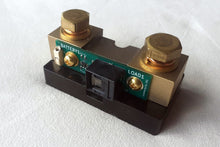More than a BMS, it is an Energy Management System!
TAO BMS is unique by the level of protection it provides and
a number of features designed to maximize battery life.
TAO BMS instillation and user manual
The features that make TAO BMS unique:
- Up to twenty ranges can be defined for cell voltage, cell temperature or battery state of charge
- Close integration with external equipment to command their operation (6 relays and CAN messages)
- Alarms are activated and custom commands are sent to external equipment when a range limits are reached
- Anticipated warning before a command is sent out
- Warning on cell voltage and temperature differential
- Control of the charge cycle
- Dynamic cell balancing (4 A) as soon as there is a voltage differential between cells
- Diagnostics and simulation mode to validate proper operation of the BMS and all external equipment
- Detailed lifetime history of events and measures to analyze cell behavior and identify slow drifts
- Battery state of health based on individual cell resistance and measured battery capacity
- Access battery state and historical data from the other end of the world.
The pitfalls of most BMS
A single protection range
-
usually that single range is close to the “Extreme” range
-
it will not prevent situations that speed up cell ageing
No anticipated warning
-
no time to take corrective actions before the power goes down
No relay outputs
-
the only action the BMS does is shut down the battery leaving you in the dark
Only two relay outputs
-
no possibility to connect directly to equipment with different command requirements
-
does not allow for controlling energy production, energy usage or environment (battery cooling & heating)
No CAN integration with external equipment
-
charge and discharge rates cannot be adjusted based on battery condition
No validation that commands sent to external equipment are effective
-
cannot validate the BMS is sending the right commands at the right time
-
cannot validate proper wiring of external equipment
-
cannot check if external equipment is working properly
No charge cycle management
-
best charge practices cannot be enforced (charge the battery up to a certain level then stop, and wait until the state of charge goes down to restart the charge – for example: stop charging at 80 %SOC and restart charging at 25 %SOC)
-
no possibility to command a periodic full charge
Passive cell balancing
-
energy is dissipated in the BMS, heating up it’s components and making its measures inaccurate
Balancing start on high cell voltage or large cell voltage differential (100 mV or more)
-
balancing always starts above the “optimal” range (unless the unbalance is very important)
-
balancing is active only for a short time before the chargers go to float or the BMS shuts down the battery
Low balancing current (less than 2 A)
-
if balancing starts on high cell voltage or large cell voltage differential, there is not enough current and not enough time to bring the cells back into balance
-
cells with the most charge will age faster and eventually bring the battery down
No history of measures or events
-
cannot claim battery warranty as it is impossible to show how the battery has been used
-
slow drifts are detected only when it is too late and the battery has been damaged
-
cannot identify situations that do not warrant an alarm but can damage the battery over time (example: keeping the battery or a cell above 80 %SOC or above 30 °C)
No warning on cell voltage or temperature differential
-
you will not be alerted if there is a difference in cells characteristics or a faulty cell interconnection that may damage the battery over time
You will need to get a few relays to complete your build. Please read this article on choosing the right relay.
Proudly made in New Zealand.






